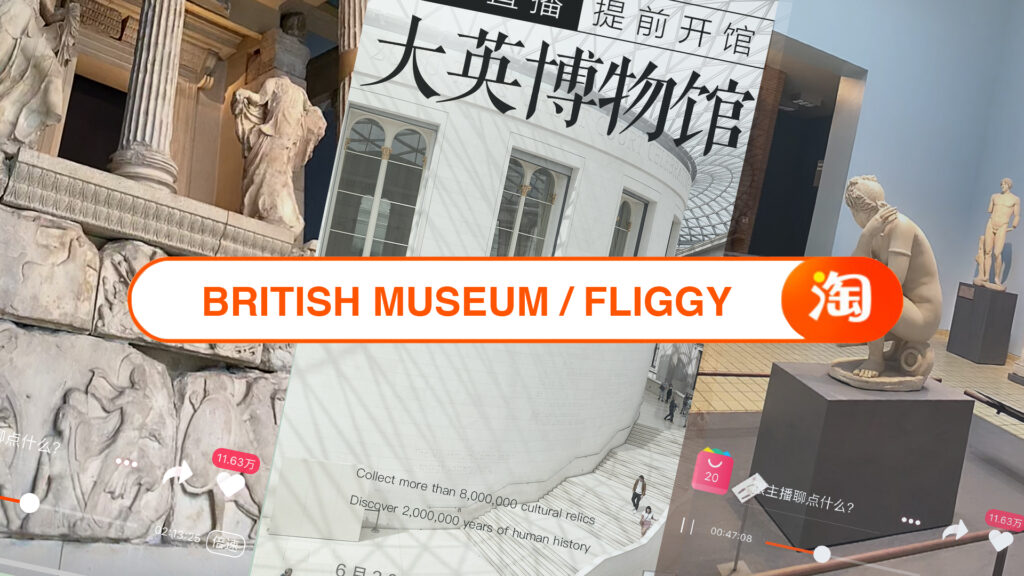Throughout China’s breakneck ascendance to becoming the globe’s largest and most lucrative travel market, no destination has held more allure and greater social cache than Europe — in 2018, 6 million Chinese tourists traveled to Europe and spent $16.5 billion, by comparison, the U.S received less than half these numbers.
A bevy of Chinese tech juggernauts have facilitated romantic Italian getaways and sojourns on the French Riviera with dynamic mobile apps that support the full travel process from searching to booking to on-the-ground navigation. Prime among these is Fliggy, Alibaba’s travel platform.
Coronavirus may have curtailed outbound travel to Europe in 2020, but Fliggy has continued connecting Chinese audiences with European destinations, most notably via livestreams.
Since May, Fliggy has broadcast livestreams from Serbia, Finland, Germany, and the U.K. as well as from some of the continent’s most storied cultural destinations including the Palace of Versailles, the British Museum, and Madrid’s Prado.
We spoke to the Fliggy team to better understand this moment, the company’s pivot into livestreaming, and how it’s helping destinations connect with China.
How would you explain Fliggy’s role in China’s outbound tourism market to those unfamiliar with the platform?
As Alibaba Group’s travel services platform, Fliggy works with transportation, accommodation, and tourist destinations from all over the world.
Fliggy acts as a one-stop shop for Chinese travelers to book global travel services, such as flights, train or ferry tickets, hotels, tourist attractions, shows, exhibitions, car rentals, restaurant reservations, visa services and more. Our goal is to enable Chinese travelers to experience local lifestyles and discover new places around the world.
In the absence of outbound Chinese travel, Fliggy has leaned heavily into livestreaming, can you discuss this initiative?
The pandemic has highlighted the importance of digital travel experiences and we are focused on helping our global partners accelerate their adaption of offline-online integration.
Fliggy has developed livestreaming partnerships with European travel organizations during COVID-19, the purpose is to “bring” Europe to Chinese tourists and maintain the link. Livestreaming is the best way to do that, they provide a dynamic and interactive way to engage future travelers by giving viewers a sense of what being in a certain place actually feels like, in real-time.
Viewers can also engage with livestream hosts through the platform by asking questions or requesting to see specific locations.
One focus has been cultural institutions with Fliggy hosting livestreams at Versailles, The British Museum, and The Prado, could you talk about this?
Despite suspended global travel, Chinese travelers’ desires to appreciate the beauty and art in Europe has not dampened, which makes this an opportune moment for cultural institutions and travel attractions to continue engaging via livestreams.
For instance, before COVID-19 Fliggy has been working with the Palace of Versailles to enable travelers to book tickets and during the pandemic, we further collaborated with Versailles to kick off the first European travel livestream series.
How did the Versailles livestream go?
The president and general manager of the Palace of Versailles gave an exclusive two-hour “VIP tour,” allowing viewers to visit the palace up close and even see areas that are normally off limits to regular visitors. Within the first five minutes of the virtual tour, more than 10,000 viewers tuned into the livestream.
What are the keys to a successful cultural livestream?
One of the best ways to engage with Chinese travelers is to focus on the details, anecdotes or little-known facts about things they are seeing on camera. Chinese travelers enjoy learning things on livestreams that they cannot read about in travel books or websites. When travel eventually resumes under safe conditions, these destinations can build upon the virtual experiences and relationships they’ve built during this time, and attract tourists more effectively.

Chinese audiences are increasingly visiting cultural institutions via livestream with Alibaba’s tour of eight Chinese museums in February drawing 10 million viewers. Image: Fliggy.
What else should tourism destinations and cultural destinations know about livestreaming?
The first thing that museums and cultural destinations need to know is that setting up a livestream is actually relatively simple and easy. They are conducted entirely through smart phones, and generally do not require special set-up or large equipment. Livestreams to Chinese travelers also benefit from having a translator on camera, who can translate content in real-time.
Practically speaking, what does it mean to partner with Fliggy and what are the advantages?
Many cultural destinations, hotels, and even cities, work with Fliggy to build customized flagship stores on Fliggy’s platform. These storefronts are one-stop shops that allow Chinese travelers to browse information, recommendations, coupons, as well as travel packages and tickets – all within a few clicks on the Fliggy app.
Fliggy is part of the wider Alibaba Group digital economy, so when an organization partners with Fliggy, they are also able to tap into Alibaba’s leading technologies in payments and e-commerce so that they can better form a holistic and comprehensive China strategy.




